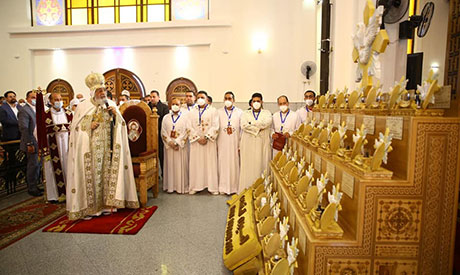
Pope Tawadros II during the 40th Holy Chrism Oil preparation in Coptic Orthodox Church.
Pope Tawadros II of Alexandria and Patriarch of the See of St Mark led on Wednesday the ritual preparation of the holy chrism oil for the 40th time in the history of the Coptic Orthodox Church and the third time in the pontificate of the 118th Patriarch of the Church.
The rituals and prayers will last for two days in the Monastery of St Bishoy, located in northern Egypt’s Wadi Al-Natroun, in the presence of the majority of the members of the Holy Synod.
Participants in the event adhered to coronavirus precautionary measures, wearing masks and maintaining social distance.
The chrism oil (also known as Myron oil) is composed of twenty-seven components extracted from aromatic substances and are found in plants, as inspired by the Bible, Pope Tawadros II explained.
The restrictions imposed by the church on various activities due to the coronavirus pandemic led to interruptions in the production of the holy chrism last year, the Pope added.
“We’re making 620 kilograms of the holy chrism oil and 380 kilograms of the Ghalilawn oil this year,” said the Pope.
What is the holy chrism?
Chrismation is one of the seven sacraments of the Coptic Orthodox Church, four of which are known as the secrets of salvation and which every Christian is expected to perform.
These four secrets are baptism, chrismation (confirmation), communion, and confession. The other three secrets are marriage, priesthood, and anointing the sick.
The apostles and disciples of Christ were the first to make the holy chrism, as referred to in John 2:20 and 27. After this, Saint Mark brought the chrism to Egypt and its use has continued consecutively throughout the ages of Coptic popes, who are the successors of Saint Mark.
The chrism is a mixture of virgin olive oil and around 27 aromatic essences. Some of the substances used in this holy anointing oil were mentioned in the Old Testament book of Exodus.
Among them are the oils of cloves, sandalwood, liquid amber, and balsam. Some of the ingredients are found in Egypt and some are imported from abroad while the pure olive oil comes from the produce of the Baramous Monastery in the Western Desert.
The traditional method of extracting these oils from plants is based on some chemical processes, which consume a lot of time and effort, in addition to the loss of up to 30 percent of volatile aromatic substances during heating.
Since 2014, the begining of tenure of the pontificate of Pope Tawadros II, the Orthodox Church began, after the approval of members of the Holy Synod, to bypass the arduous step of extracting the 27 aromatic oils and use modern science and technology to develop the process of producing the chrism.
“The new method,” the Pope said, “has the added value of allowing us to make a bigger quantity of Myron Oil since it simplifies the process.”
When is the Holy Myron Used?
It is used in several occasions. After the priest finishes the actual rites of baptism, he anoints the baptised on the crowd of his/her head with chrism, saying, "God the Father of our Lord Jesus Christ has freed you from sin and given you a new birth by water and the Holy Spirit."
Bishops anoint their palms and foreheads with chrism during their ordination rites.
Chrism is also used in a church's dedication ceremony. Here the bishop anoints the altar, pouring holy chrism on the middle and on each of its four corners, and then anoints the walls of the church, marked by crosses in twelve places (referring to the 12 apostles) or four places (referring to the cardinal directions).
Anointing with the holy chrism oil, locally known as Myron oil, is a well-known rite in the Catholic Church, the Armenian Apostolic Church, and the Eastern and Coptic Orthodox churches.

All photos courtesy of the Facebook page of the Coptic Orthodox Church
Short link: